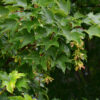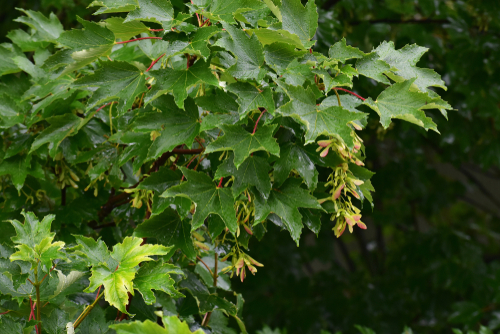Acer pseudoplatanus / Sycamore
Price range: £250.00 through £425.00
Frequently Bought Together




Description
Quick Facts
- Common Name: Sycamore, Sycamore Maple, Great Maple
- Botanical Name: Acer pseudoplatanus
- Plant Type: Deciduous tree
- Mature Height: 25-35m
- Mature Spread: 15-20m
- Flowering Period: April to June
- Flower Colour: Yellow-green flowers in pendulous clusters
- Foliage: Large palmate leaves, dark green with grey-green undersides, turning yellow-brown in autumn
- Hardiness: RHS H7 (very hardy)
- Soil Requirements: Moist, well-drained, tolerates most soil types
- Aspect: Full sun to partial shade
- Maintenance: Low
Description
Experience the majestic beauty of Acer pseudoplatanus, the magnificent Sycamore that brings exceptional stature, outstanding resilience, and commanding presence to large gardens with its remarkable tolerance of the most challenging conditions. This outstanding native deciduous tree offers remarkable qualities—exceptional tolerance of exposure, salt spray, and coastal winds making this one of the finest trees for exposed and coastal locations where few large trees will thrive, impressive pendulous clusters of yellow-green flowers in spring that provide valuable nectar for bees and other pollinators followed by attractive winged seeds that spin like helicopters delighting children, large handsome palmate leaves creating dense canopy and excellent shade throughout summer, and vigorous adaptable nature tolerating urban pollution, poor soils, and the harshest British weather conditions making this one of the toughest and most reliable large trees available, making this one of the finest choices for creating substantial shade, windbreaks, shelter belts, and robust beauty in large exposed gardens, estates, coastal properties, and parklands.
Throughout spring and summer, this captivating tree displays its characteristic large palmate leaves measuring 10-25cm across with five coarsely toothed lobes in dark green on the upper surface with distinctive grey-green to almost white undersides, creating bold foliage that rustles beautifully in the wind. The leaves are held on long reddish stalks. The overall effect is substantial and commanding. In spring (April-June), the tree produces hanging pendulous clusters (racemes) measuring 10-20cm long of small yellow-green flowers that dangle gracefully from the branches after the leaves have emerged. The flowers provide important nectar for bees and other pollinators. The flowers are followed by the tree’s most distinctive feature—masses of winged seeds (samaras) arranged in pairs with wings at right angles forming a distinctive right-angle shape. These ripen to brown and spin like helicopters as they fall in autumn, providing endless fascination for children and self-seeding readily. In autumn, the foliage turns yellow-brown—not the most spectacular autumn colour but reliable. The grey-brown bark becomes fissured and flakes in irregular plates with age, revealing pinkish-orange patches beneath. The broad domed crown creates impressive stature.
Native to central and southern Europe and naturalized in Britain and Ireland for centuries (possibly introduced by the Romans), Acer pseudoplatanus has become one of our most familiar large trees. The species name ‘pseudoplatanus’ means false plane, referring to the leaf shape resembling Platanus (plane trees). Despite sometimes being dismissed as too common, this is an exceptional tree for difficult sites. Exceptionally hardy, vigorous, and remarkably wind-tolerant, this sycamore thrives in British conditions better than almost any other large tree, tolerating salt spray, coastal exposure, harsh winds, urban pollution, compacted soils, and poor conditions where other trees struggle or fail. The ability to withstand extreme exposure makes this invaluable for coastal gardens, exposed hilltops, or as windbreak and shelter belt plantings. Fast-growing, establishing quickly and providing substantial shade and shelter within 15-20 years. Long-lived (200-400 years). NOTE: Self-seeds prolifically—seedlings may need managing in gardens.
Create stunning compositions by planting as substantial specimen trees in large gardens, estates, coastal properties, or exposed sites where the exceptional wind tolerance and commanding size create shelter and presence. Exceptional as windbreak and shelter belt plantings in exposed locations where the tolerance of harsh conditions is invaluable—plant in groups or rows to create effective shelter for gardens and buildings. Works beautifully in parklands, naturalistic landscapes, or as shade trees for large lawns. Magnificent in coastal gardens where salt tolerance makes this one of the few large trees that will thrive. NOT suitable for small or medium gardens—this is a very large, vigorous tree that needs substantial space and can self-seed prolifically. Perfect for large exposed properties, coastal estates, or parklands where robust shelter, substantial shade, and commanding presence are needed.
Caragh Garden Notebook
Planting: Space trees 15-20m apart for windbreak/shelter belt plantings, or allow 20-25m for specimen placement to accommodate the very large mature spread—this tree needs exceptional space. Plant bare-root trees from November to March (ideal), or container-grown specimens year-round. Dig holes twice the width of the root ball and incorporate organic matter. Plant at the same depth as the nursery soil mark. Stake securely for the first 3-5 years. Water thoroughly and mulch around the base. Particularly valuable for exposed and coastal sites where wind tolerance is essential. Not suitable for small or medium gardens—this is a very large tree.
Soil Preparation: Thrives in moist, well-drained soil with pH 4.5-8.0. Tolerates an exceptionally wide range of soil types including clay, loam, sand, chalk, limestone, and very acidic to alkaline conditions. Adapts to poor soils, compacted soils, and challenging conditions better than most large trees. Dislikes only severely waterlogged sites. Tolerates urban pollution, salt spray, coastal exposure, and extreme wind exposure better than almost any other large tree. Best growth occurs in reasonably fertile soil with consistent moisture, but this is one of the most adaptable and forgiving large trees for difficult sites.
Container Growing: Not suitable for container growing due to very large size, exceptionally vigorous growth, extensive root system, and need for space to develop the characteristic broad domed crown and substantial stature. This is a tree for planting in the ground in large gardens, estates, exposed sites, coastal properties, or parklands where it can reach its full impressive potential and provide the exceptional wind tolerance, shelter, and shade.
Seasonal Care: Requires minimal pruning—the naturally domed form develops without intervention. Remove only dead, damaged, or crossing branches in late autumn or winter when dormant. If formative pruning is needed, do so when young to establish a strong central leader and well-spaced branches. Avoid pruning in late winter or early spring as maples can bleed sap profusely—prune in late summer to autumn or mid-winter. Can be pollarded if needed for size control. Apply slow-release balanced fertiliser in early spring if desired, though established trees require no feeding. Mulch annually with organic matter. Water during dry spells in the first 5-7 years until established. IMPORTANT: Self-seeds prolifically—seedlings will appear throughout the garden and may need removing to prevent unwanted spread. Generally pest and disease resistant, though can occasionally be affected by aphids (producing honeydew), tar spot (black spots on leaves—cosmetic only), or sooty bark disease in hot dry summers. Generally very robust and trouble-free.
Propagation: Grows readily from seed collected from ripe samaras in autumn—often too readily, as this tree self-seeds prolifically throughout gardens. Seeds require cold stratification over winter. Sow in autumn in pots outdoors—germination occurs in spring and seedlings grow vigorously. Selected cultivars (such as ‘Brilliantissimum’, ‘Atropurpureum’, ‘Leopoldii’) are propagated by grafting onto A. pseudoplatanus rootstock. Home gardeners can easily grow from seed, though managing unwanted seedlings may become necessary. Purchase nursery-grown specimens for immediate impact.
This majestic beauty is absolutely exceptional for challenging conditions—one of the toughest and most wind-tolerant large trees available! That remarkable tolerance of exposure, salt spray, and coastal winds makes this invaluable for exposed and coastal sites where few large trees will thrive. Pendulous yellow-green flowers provide nectar for pollinators, those spinning helicopter seeds delight children, and the dense canopy creates excellent shade and shelter. Exceptionally hardy, fast-growing, long-lived, and adapts to poor soils brilliantly. CRITICAL: needs substantial space and self-seeds prolifically—manage seedlings. Perfect for large exposed properties, coastal estates, windbreaks, and shelter belts. Unbeatable resilience and commanding presence!





